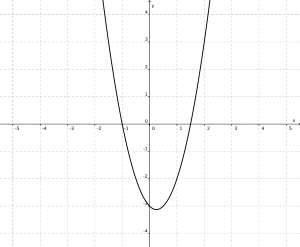Finding solutions to quadratic equations
Let’s start with some images!
Now, to the specifics on solving quadratic equations…
Contents
The zero factor principle
When we have factors that when multiplied together give us an answer of zero, we know that at least one of our factors is zero.
A product is equal to zero when the first factor is zero, for example [math](0)(6) = 0[/math].
And, a product is equal to zero when the second factor is zero, for example [math](6)(0) = 0[/math].
Let's take a look at two factors--denoted by A and B--that when multiplied together result in an answer of zero. From the example above, we know that we get an answer of zero when A=0 (the first factor) and when B=0 (the second factor). Let's write this out using mathematical notation:
(A)(B) = 0
For A=0, (0)(B) = 0
For B=0, (A)(0) = 0
Therefore, the solutions--the values of A and B that give us an answer of zero--to the equation (A)(B) = 0 are:
A = 0 , B = 0
Solve for [math]x[/math] example 1: [math](x)(x-1) = 0[/math]
Again, we have two factors [math](x)[/math] and [math](x-1)[/math] that are multiplied together to give an answer of zero. Just like the example above where we found A and B when (A)(B) = 0, we find the solutions to this problem by setting each factor equal to zero. The first factor is [math]x[/math] and the second factor is [math]x - 1[/math].
The first factor is equal to zero when [math]x = 0[/math] and the second factor is zero when [math]x - 1 = 0[/math]. So, to solve for [math]x[/math], we have
The first factor is solved for [math]x[/math], [math]x = 0[/math]. However, we need to solve the second factor for [math]x[/math] by adding [math]1[/math] to both sides of the equal sign:
[math]\begin{align} x - 1 &= 0 \\ x - 1 + 1 &= 0 + 1 \\ x &= 1 \\ \end{align}[/math]
The following two values for x are solutions to the equation [math](x)(x - 1) = 0[/math]:
We can check our answers by substituting the values into the original equation: [math](x)(x - 1) = 0[/math].
- When [math]x = 0[/math],
- [math]\begin{align}(x)(x - 1) &= 0 \\ (0)(0 - 1) &= 0 \\ (0)(-1) &= 0\end{align}[/math]
- When [math]x = 1[/math],
- [math]\begin{align}(x)(x - 1) &= 0 \\ (1)(1 - 1) &= 0 \\ (1)(0) &= 0\end{align}[/math]
We get [math]0=0[/math] in both cases, so our solutions check out.
Solve for [math]x[/math] example 2: [math](x - 5)(x - 8) = 0[/math]
Set each factor equal to zero: [math](x - 5) = 0[/math] and [math](x - 8) = 0[/math].
Solve for [math]x[/math] in the first factor:
[math]\begin{align} x - 5 &= 0 \\ x - 5 + 5 &= 0 + 5 \qquad \text{add 5 to both sides of the equal sign} \\ x &= 5 \\ \end{align}[/math]
Solve for [math]x[/math] in the second factor:
[math]\begin{align} x - 8 &= 0 \\ x - 8 + 8 &= 0 + 8 \qquad \text{add 8 to both sides of the equal sign} \\ x &= 8 \\ \end{align}[/math]
We have two solutions for x: [math]x = 5 \quad x = 8[/math].
To check our answers:
- First evaluate [math](x - 5) (x - 8) = 0[/math] when [math]x = 5[/math]
- [math]\begin{align}(x-5)(x - 8) &= 0 \\ (5-5)(5 - 8) &= 0 \\ (0)(-3) &= 0\end{align}[/math]
- Then evaluate [math](x - 5)(x - 8) = 0[/math] when [math]x = 8[/math]
- [math]\begin{align}(x-5)(x - 8) &= 0 \\ (8-5)(8 - 8) &= 0 \\ (3)(0) &= 0\end{align}[/math]
Again, we get [math]0=0[/math] in both cases, so our solutions check out.
Solve for [math]x[/math] example 3: [math](x - 9)(3x - 12) = 0[/math]
Set each factor equal to zero: [math]x - 9 = 0[/math] and [math]3x - 12 = 0[/math].
Solve for [math]x[/math] in the first factor:
[math]\begin{align} x - 9 &= 0 \\ x - 9 + 9 &= 0 + 9 \qquad \text{add 9 to both sides of the equal sign} \\ x &= 9 \\ \end{align}[/math]
Solve for [math]x[/math] in the second factor:
[math]\begin{align} 3x - 12 &= 0 \\ 3x - 12 + 12 &= 0 + 12 \qquad \text{add 12 to both sides of the equal sign} \\ 3x &= 12 \\ \frac{3x}{3} &= \frac{12}{3} \qquad \text{to isolate} \ x \ \text{on the left, divide both sides of the equal sign by 3} \\ x &= 4 \\ \end{align}[/math]
Our solutions to the equation [math](x - 9)(3x - 12) = 0[/math] are [math]x = 9, \quad x = 4[/math].
When a quadratic equation needs to be factored first
An equation in the form [math]ax^2 + bx + c = 0[/math] is called a quadratic equation.
To solve a quadratic equation, we need zero on one side of the equal sign and we need to write the [math]ax^2 + bx + c[/math] part of the equation in factored form. In this way, our equation will look similar to the examples above, and we can set each factor equal to zero and solve for the variable.
Solve for [math]x[/math] example 4: [math]x^2 + 8x + 12[/math]
This is a quadratic equation where [math]a=1[/math], [math]b=8[/math] and [math]c=12[/math]. We know that in order to solve for [math]x[/math], we must rewrite the equation in factored form. The factors of the first term, [math]x^2[/math], are [math]x[/math] and [math]x[/math]; the factors of the last term, [math]12[/math] that will result in a middle term of [math]8x[/math] are [math]6[/math] and [math]2[/math].
The factored form of [math]x^2 + 8x + 12[/math] is [math](x + 6)( x+ 2) = 0[/math].
Now we can proceed as before. Set each factor equal to zero: [math]x + 6 = 0[/math] and [math]x + 2 = 0[/math].
Solve for [math]x[/math] in the first factor:
[math]\begin{align} x + 6 &= 0 \\ x + 6 - 6 &= 0 - 6 \qquad \text{subtract 6 from both sides of the equal sign} \\ x &= -6 \\ \end{align}[/math]
Solve for [math]x[/math] in the second factor:
[math]\begin{align} x + 2 &= 0 \\ x + 2 - 2 &= 0 - 2 \qquad \text{subtract 2 from both sides of the equal sign} \\ x &= -2 \\ \end{align}[/math]
Our solutions to the equation [math]x^2 + 8x + 12[/math] are [math]x = -6 \quad x = -2[/math].
Solve for [math]y[/math] example 5: [math]2y^2 + 11y + 12 = 0[/math]
In this quadratic equation, [math]a = 2[/math], [math]b = 11[/math], and [math]c = 12[/math]. We need to factor the equation in order to solve for [math]y[/math]. The factors of the first term, [math]2y^2[/math], are [math]2y[/math] and [math]y[/math]. The factors of [math]12[/math], the last term, that will result in a middle term of [math]11y[/math] are [math]3[/math] and [math]4[/math].
The factored form of [math]2y^2 + 11y + 12[/math] is [math](2y + 3)(y + 4) = 0[/math].
Set each factor equal to zero: [math]2y + 3 = 0[/math] and [math]y + 4 = 0[/math].
Solve for [math]y[/math] in the first factor:
[math]\begin{align} 2y + 3 &= 0 \\ 2y + 3 - 3 &= 0 - 3 \qquad \text{subtract 3 from both sides of the equal sign} \\ \frac{2y}{2} &= \frac{-3}{2} \qquad \text{divide both sides of the equal sign by 2} \\ y &= \frac{-3}{2} \\ \end{align}[/math]
Solve for [math]y[/math] in the second factor:
[math]\begin{align} y + 4 &= 0 \\ y + 4 - 4 &= 0 - 4 \qquad \text{subtract 4 from both sides of the equal sign} \\ y &= -4 \\ \end{align}[/math]
Our solutions to the equation [math]2y^2 + 11y + 12 = 0[/math] are [math]y = -\frac{3}{2} \quad y = -4[/math].
Solve for [math]y[/math] example 6: [math]y^2 - 16 = 0[/math]
For this equation, [math]a = 1[/math], [math]b = 0[/math], and [math]c = -16[/math].
Factor the equation as a difference of two squares: [math](y + 4)(y - 4) = 0[/math].
Set each factor equal to zero: [math]y + 4 = 0[/math] and [math]y - 4 = 0[/math].
Solve for [math]y[/math] in the first factor:
[math]\begin{align} y + 4 &= 0 \\ y + 4 - 4 &= 0 - 4 \qquad \text{subtract 4 from both sides of the equal sign} \\ y &= -4 \\ \end{align}[/math]
Solve for [math]y[/math] in the second factor:
[math]\begin{align} y - 4 &= 0 \\ y - 4 + 4 &= 0 + 4 \qquad \text{add 4 to both sides of the equal sign} \\ y &= 4 \\ \end{align}[/math]
Our solutions to the equation [math]y^2 - 16 = 0[/math] are [math]y = -4 \quad y = 4[/math].
Why do quadratic equations have two solutions?
A quadratic equation is an equation with a second-degree term, and no higher terms. A second-degree term is one which includes a variable with an exponent of [math]2[/math]; in a quadratic equation of the form [math]ax^2 + bx + c[/math], the second degree term is [math]ax^2[/math]. The degree of an equation is the degree of the equation's highest term and tells you how many solutions an equation has, so a quadratic equation has 2 solutions. Similarly, if the degree of an equation is three, there are three solutions to the equation. However, sometimes, as in the next example, we get only one solution because the solution is repeated.
Solve for [math]x[/math] example 7: [math]x^2 +4x + 4 = 0[/math]
For this equation, [math]a = 1[/math], [math]b = 4[/math], and [math]c = 4[/math].
The factors for this equation are: [math](x + 2)(x + 2) = 0[/math].
Set each factor equal to zero: [math]x + 2 = 0[/math] and [math]x + 2 = 0[/math].
Solve for [math]x[/math] in the first factor:
[math]\begin{align} x + 2 &= 0 \\ x + 2 - 2 &= 0 - 2 \qquad \text{subtract 2 from both sides of the equal sign} \\ x &= -2 \\ \end{align}[/math]
Solve for [math]x[/math] in the second factor:
[math]\begin{align} x + 2 &= 0 \\ x + 2 - 2 &= 0 - 2 \qquad \text{subtract 2 from both sides of the equal sign} \\ x &= -2 \\ \end{align}[/math]
Because the two factors are the same, the solutions to the equation [math]x^2 +4x + 4 = 0[/math] are in fact only one solution: [math]x = -2[/math].

